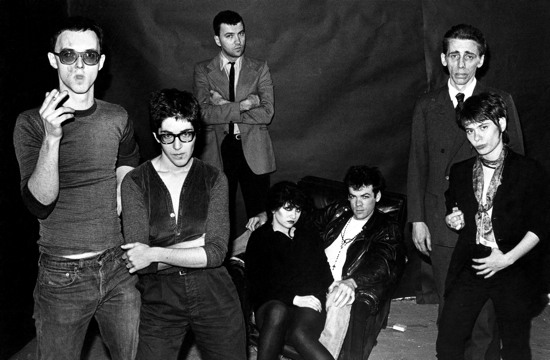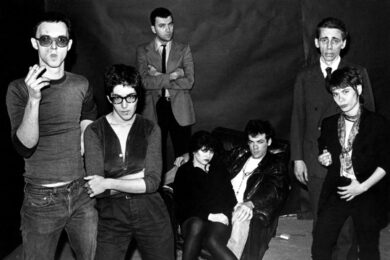Here’s a new diversion: watch Blank City, director Céline Danhier’s documentary about the late ’70s No Wave cinema scene on Manhattan’s Lower East Side, and marvel as your favourite post-punk idols attempt to out-mythologise one another. The era was one of the most fertile of the 20th century for challenging, low-budget creativity forced into existence by the social conditions of a time and a place, and the stories are manifold. Everybody’s got one; everyone delivers theirs with a wry smile, as if to say ‘we were there, don’t you wish you were too?’.
Most people who’ve read a review of an LCD Soundsystem album know who James Chance or Liquid Liquid are, but Danhier’s fresh spin on chronicling the era is to concentrate upon the filmmakers whose work existed in symbiosis with that of the music community. In fact, there was often no separation between the two. Chance, Lydia Lunch, Debbie Harry – all these and more would show up with varying degrees of ability in front of the camera. Jim Jarmusch recalls fondly his old band the Del-Byzanteens. Amateurism was the only prerequisite to joining a group or picking up a camera, in a scene where "proficiency was hated", and the guy or girl you were watching onstage at CBGBs or Max’s Kansas City didn’t know what they were doing either.
In this parallel history of No Wave New York, year zero didn’t arrive with the trashy punk of the New York Dolls, but with the gathering call of Amos Poe’s 1976 film The Blank Generation, an indie doc which introduced the sights and sounds of Television, Talking Heads and Patti Smith. Poe features here, a remarkably sober individual for one whose introduction to photography was as an imagined means of stealing superstitious village folks’ souls while visiting family in the Carpathian mountains, and who hammered the film together in muso-doc legends the Maysles brothers’ edit suite in one day while shedded on speed.
Bresson, Antonioni, Cassavetes and Godard were Poe’s heroes, the latter because he too would shoot using a handheld camera and without artificial lighting. Budgets were microscopic, and films were completed amid great emotional duress through sheer force of will. Poe recalls shooting his Blank Generation follow-up Unmade Beds on one of the cheap Super 8s that had started to crop up in hardware stores. By the time it was finished he had a new baby, a wife in a mental institution and the city was smothered under a "Doctor Zhivago winter". But he had his film, and was thinking about the next one: it was a "best time, worst time" point in his life.
"It’s not that we wanted to make films for nothing," says James Nares, the émigré English painter and director, "but we wanted to make films, and if we had nothing…" The grinding deprivation which fired the work is delved into, often to compelling period clips of waif-like young women and lean-necked studs in vests and leather jackets mooching around the abandoned streets. Arson and fly-tipping appeared to be recreational sports in those days and, rebutted by the then-President’s infamous ‘Ford To City: Drop Dead’ (as rather sensationally reported by the New York Daily News) denial of extra funds, a near-bankrupt NYC could do precious little about it.
King Blank director Michael Oblowitz speaks of biblical swarms of rats flowing through the derelict houses. Michael DeLanda made a film about the cockroaches that lived in his apartment, which showed what he calls the desperation in their faces. John Waters’ amusement at the memory of being mugged regularly is almost childish. Oblowitz, forcing memories of last summer’s riots in England and gently tying together the causal link between creation and destruction, remembers of mass disturbances during the 1977 blackout: "seeing people smashing the windows of department stores, it was like an incredible act of liberation. The rule of law could just totally explode. It terrified me and it excited me".
‘Nihilism’ is a word that’s used over and over. There was "no forethought, no afterthought, no ambition, no thoughts of the future," says Lunch, a dependably quotable figure. These people "just needed to get it out". Criminality and derangement are never far from the surface. Teenage Jesus and the Jerks drummer Bradley Field was an "alcoholic madman" trying to douse the fire he’d lit on a vagrant with his boots when Lunch discovered him on the street. They soon established he couldn’t play drums "but he can play drum" – and there he is bashing away on a single skin. In finding locations for his demented Roman Empire by way of the Bowery flick Rome ’78, Nares viewed an impressive domed building as if he were a buyer, flicking open a window catch as he toured. That night, cast and crew broke in and shot their scenes.
Of course, eventually everyone got famous and successful and it all went to shit. The fury of the immediate post-Vietnam, pre-Reagan era descended into well-off complacency as nearby Wall Street boomed, rents got higher and art galleries started to open by the dozen (Sonic Youth’s Thurston Moore remembers surviving on a diet of wine and hors d’oeuvres, skulking from opening to opening). The landlord of the seminal New Cinema on St. Mark’s Place bumped the rent up and it had to close. MTV arrived.
John Lurie, a gruff character who founded pseudo-jazz outfit the Lounge Lizards, starred in Jarmusch’s Stranger Than Paradise and used to fund his films by staging the robbery of his saxophones and claiming the insurance money, blames Jean-Michel Basquiat because he hung out with Warhol and made the earning of lots of money fashionable. But the Basquiat-starring Downtown 81, as we can tell from the footage here, is one of the purest documents of this time.
There was a brief, bright foray into hip-hop with Charlie Ahearn’s Wild Style, then things in the ’80s soured. AIDS arrived, heroin use rose, people died. The city began to fight back against the Lower East Side’s destitution and crime, and the cops pulled no punches. As times became darker so did the films. Nick Zedd’s Cinema of Transgression manifesto would draw together artists like Richard Kern and Casandra Stark Mele, people whose bad taste and effrontery was a political reaction against a city and a nation that was beginning to sweat them out as if they were a virus.
In Danhier’s simple format of talking heads and stock footage – most of it from the movies discussed – there is little of the innovation of No Wave Cinema, but her interviewees (including Harry, Jarmusch and Steve Buscemi) are well-chosen, eloquent and high-profile. Their words and the images they shot or appeared in recall a different, alien New York alive with danger and possibility, a place where these characters recreated their own existence with what Lunch refers to as a state of "semi-documentary possibility". It felt in those times, says Harry, like their very lives were cinematic experiences.
Blank City opens at select cinemas nationwide today, full list here. The film will screen at London’s ICA until March 15, with director Celine Danhier giving two talks as part of this extended run.



